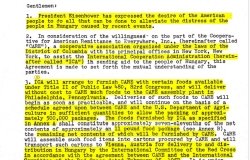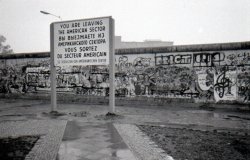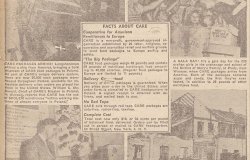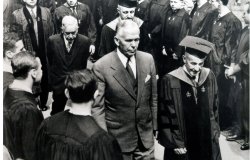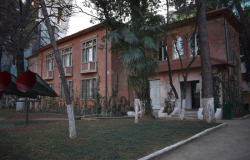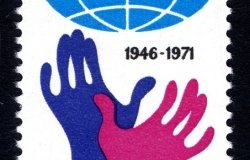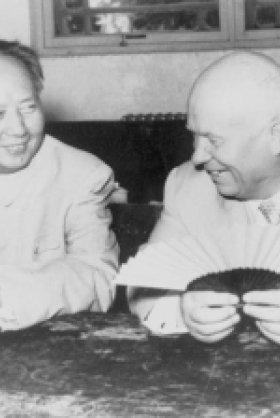"A mass psychotic movement washing over the country like a wave": NATO's Dual-Track Decision
CWIHP e-Dossier No. 21
Author: Ruud van Dijk, University of Amsterdam
Introduction1
Nowhere in Europe was NATO's 1979 dual-track decision more controversial than in the Netherlands. Anti-nuclear sentiments among the public found strong echoes in the Dutch parliament in the late 1970s, making it impossible for the center-right coalition government of Christian-Democrats (CDA) and conservatives (VVD), led by Christian Democrat Andries (Dries) van Agt, to participate fully in the alliance's planned deployment of a new generation of intermediate nuclear missiles (Theater Nuclear Forces, TNF) in Western Europe.2
At the alliance's Brussels meeting on 12 December 1979, therefore, Dutch defense minister Willem Scholten stated that while accepting the need for a response to Soviet deployments in this area, his government could not commit itself yet to deploy its share of the new missiles (48 Ground Launched Cruise Missiles--GLCMs). Instead, it would decide after two years, in December 1981, following an evaluation of the results of East-West negotiations (the second envisioned track of the NATO modernization program) over these weapons.3
December 1981 came with negotiations having just gotten underway, so The Hague postponed again. In June 1984 yet another delay followed, and it wasn't until November 1985 that the Netherlands became the last of the participants in the modernization scheme to accept deployment. Thanks to the 1987 INF treaty, the missiles, planned to arrive in 1988, never entered Dutch territory.
Public aversion to what many Dutch saw as an escalation of the arms race had much to do with the various postponements.4 More directly responsible were Dutch politics, particularly the fact that for various reasons no parliamentary majority for an unequivocal decision to deploy could be found prior to November 1985. The various Dutch cabinets between 1979 and 1985 claimed that they were caught between a desire (shared, ironically, by a majority of the population) to be a reliable member of the Atlantic alliance on the one hand, and the unmistakable, widespread opposition in the Netherlands against the introduction of the new missiles on the other. Accepting the dual-track decision while taking extra time to finalize the Dutch participation was actually the best one could do under the circumstances, the argument ran, and scenarios more disadvantageous for NATO unity were certainly possible given the state of Dutch politics. At the same time, reversing the nuclear arms race was official government policy, and cabinet ministers throughout this time period actually shared, to a greater or lesser degree, the popular reservations against the NATO program.5
The documents presented here provide insight into the reasons behind the delay of Dutch participation in NATO's dual-track decision and especially the ways in which van Agt and his foreign and defense ministers brought Dutch views to the allies in 1979.
They show how, almost until the end of 1979, the van Agt government believed it should, and perhaps could, change the alliance's plans for a deployment of 572 new intermediate nuclear missiles in Western Europe. Driven by its domestic political needs and its own convictions, the Dutch government argued that half that number of missiles would be sufficient for the time being. Later, parliament forced it also to argue for privileging arms control talks with the Soviet Union over a decision to deploy the new weapons. The documents make clear that Prime Minister van Agt, Foreign Minister Chris van der Klaauw, and Defense Minister Scholten, felt caught between their desire to have their country act as a loyal member of NATO, and growing pressures from within parliament and society at large for unilateral Dutch steps toward nuclear disarmament. Some of the skepticism vis-a-vis the alliance and its modernization plans was shared by certain members of van Agt's coalition, including members of the cabinet, while others insisted on unconditional acceptance of the dual-track decision.
The documents also shed light on the views of allied governments in the United States, Great Britain, Belgium, and Italy on both the Dutch reservations and the TNF question in general.
The first two documents, (Document No. 1, Document No. 2) connected with the visit to the Netherlands of U.S. Vice President Walter Mondale in April 1979, date from a time when NATO was still studying how it might implement TNF modernization (through the High-Level Group, HLG), and how an arms control component might be part of the program (the Special Group, SG). From van Agt's speaking notes and the meeting with Mondale itself it is clear that Dutch participation, if it was to happen at all, would not be automatic. Part of the reason, the documents show, was the legacy of the neutron bomb affair of the previous year. Opposition to the possible introduction of this new weapon had been widespread in the Netherlands, and the anti-nuclear movement that emerged from it had since only gained influence.
President Carter professed to be aware of, and sympathetic to these challenges when he wrote van Agt in July (Document No. 3) to launch concrete discussions over a Dutch participation in the modernization program. At the same time, however, the president reminded van Agt of the importance of alliance "consensus," "broad participation," and "steadfastness and determination."
The next three documents date from October, after the HLG had finalized its report, including the recommendation to deploy 572 new intermediate nuclear missiles in Europe. They show that the Dutch, unlike most of the other envisioned participants, were having great difficulties accepting the plan. They also show that relations with allies sometimes became tense. Pressed by fierce resistance to the HLG's findings from within his own party, coalition partner CDA, Defense Minister Scholten in October looked for support within NATO for a modernization plan that was more modest in scope. His alternative, and the Dutch conditions for signing on, emerge from a set of speaking notes he prepared for a meeting with U.S. Secretary of Defense Harold Brown, on 5 October (Document No. 4). The two memoranda of conversation, but especially the one from Scholten's meeting with Deputy National Security Adviser David Aaron on 22 October (Document No. 6), show how little headway he was making. One additional insight from van Agt's discussion with Italian Prime Minister Francesco Cossiga on the 13th (Document No. 5) is that in the Dutch debates at this time concerns about a Soviet threat hardly figure, while they seem to have mattered greatly to several allied governments.
At the end of October President Carter again wrote to van Agt, this time essentially to warn him that the time had passed for major alterations to the NATO modernization plan, certainly the 50% reduction proposed by the Dutch. Not all Dutch concerns were rejected. The Hague's emphasis on the need for nuclear arms control (shared by other alliance members), and even a numerical reduction in the total number of nuclear warheads in Europe even with TNF modernization, found expression in the president's promised unilateral reduction by 1000 of the U.S. nuclear stockpile in Europe. However, further pressed by the Christian Democrats in parliament, the van Agt government in early November only increased its opposition when it took it upon itself also to plead with the allies for a decoupling of the production and deployment of the new weapons. This new element became part of van Agt's reply to Carter's letter of 31 October, (Document No. 7a) which the Prime Minister did not send until 26 November (Document No. 7b).
Defense Minister Scholten, meanwhile, had made his own final pitch to several fellow NATO Defense ministers. He received a polite but firm, point-by-point refutation from his British colleague, who reminded his colleague that on several specific points Dutch concerns had actually been taken into account by NATO, and who also urged the Dutch government to consider, like his own government, TNF modernization "as a major alliance issue which we should approach above all as alliance members." (Document No. 8).
This the van Agt government was unable to do, because unconditionally accepting the modernization program--in spite of its arms control component--would have meant the loss of support of a sizable number of CDA parliamentarians and therefore the end of the CDA-VVD coalition. Because opinion polls at the time showed that its replacement was likely to be a left-of-center government more critical of NATO, a development van Agt and his colleagues wanted to avoid, the prime minister, aided by the foreign and defense ministers, devised a compromise solution: a so-called "commitment to commit" in two years time. The Dutch government would endorse NATO's dual-track decision, but postpone a decision about the country's own participation (deployment of 48 GLCMs) until December 1981 when, in consultation with the allies, it would evaluate the progress of the arms control talks on TNF between the U.S. and the Soviet Union.
This compromise van Agt set out to explain in person to the heads of government of the other participating NATO countries (Document No. 9, Document No. 10, Document No. 11, Document No. 12, Document No. 13, Document No. 14, Document No. 15). Between December 4 and 10 the prime-minister visited Brussels, Rome, London, Washington, and Bonn for face-to-face meetings with, respectively, Prime Ministers Wilfried Martens, Cossiga, and Margaret Thatcher, and with President Carter and Chancellor Helmut Schmidt. His adviser, J. P. M. H. Merckelbach, took notes and prepared hand-written summaries of these meetings, which are revealing in several ways.6
First, we get a detailed perspective on the Dutch compromise position and the reasons behind it. Second, it becomes clear that, his political position at home deteriorating further as he was having these meetings, van Agt still tried to add conditions to the Dutch "commitment to commit" in order to improve the chances that his compromise solution would indeed be accepted by parliament, his government would live to see another day, and NATO unity remained intact. Some of these conditions the allies could live with, Merckelbach's notes show, others they rejected out of hand. Thus, these memoranda are also valuable for what they tell us about the views of the allies: from the growing difficulties--thanks, in part, to the turmoil in the Netherlands--of the Belgian government with TNF modernization (Document No. 9, and Document No. 16), to Thatcher's offer to "defend the Netherlands if it does not object to that" (Document No. 11), to the United States veto of van Agt's intention to pair the Dutch "commitment to commit" with continued complaints about the size of the modernization program (Document No. 12, Document No. 13, and Document No. 14).
The possibility that Dutch opposition to TNF modernization might weaken support for the program in, for example, Belgium or the Federal Republic worried, among others, US National Security Adviser Zbigniew Brzezinski, as these documents show. In subsequent years his fears seemed to be borne out as broad popular opposition to the deployment of the new weapons manifested itself in these and other NATO member states. This may give these documents a significance that goes beyond the particular Dutch political situation in 1979. There were, of course, unique political circumstances that help explain the exceptional position the van Agt government had to claim for the Netherlands in December 1979. However, the Dutch case can also be seen as an early instance of what soon would be a more widespread phenomenon in late-Cold War Europe, namely the interference with the formulation and conduct of foreign policy by the public at large. Led by activist groups and inspired by charismatic individuals, public pressure confined policymakers in ways rarely seen before, in part because of its profound effect on national politics. Whether in 1979, as van Agt claimed, there was really "a mass psychotic movement wash[ing] over [the Netherlands] like a wave"7 or not, it was clear that something rather important had changed for foreign policy makers. Many other countries were not far behind.
Endnotes
1) These documents come from the files of the office of the Prime Minister of the Netherlands, the Dutch foreign ministry, and the papers of former Prime Minister Andries van Agt located in the archives of the Catholic Documentation Center and the Archive of the Foreign Ministry of the Netherlands. They were also reproduced in the Document Reader for the 10-12 December 2009 International Conference The Euromissiles Crisis and the End of the Cold War, 1977-1987, forthcoming from the the Cold War International History Project.
2) For NATO's decision making process see Leopoldo Nuti, "The origins of the 1979 dual track decision -- a survey." In Leopoldo Nuti, ed., The Crisis of Détente in Europe: From Helsinki to Gorbachev, 1975-1985 (London: Routledge, 2009), 57-71.
3) For an account of developments in Dutch politics and diplomacy in connection with NATO's nuclear modernization plans in 1978 and 1979, see my paper "'A Mass Psychosis': The Netherlands and NATO's Dual-Track Decision, 1977-1979," prepared for the conference The Euromissles Crisis and the End of the Cold War, 1977-1987, 10-12 December 2009, Ministry of Foreign Affairs, Rome, Italy.
4) In 1981, historian Walter Laqueur argued that this aversion was linked to Dutch traditions of neutrality, or "neutralism," and that in its Cold War guise this "Hollanditis" was spreading to other West European countries. "Hollanditis: A New Stage in European Neutralism," Commentary, 72:2 (1981), 19-26.
5) For a recent account of developments in Dutch society in connection with the NATO plans see, Remco van Diepen, Hollanditis: Nederland en het Kernwapendebat, 1977-1987 (Amsterdam: Bert Bakker, 2004); for the domestic side of Dutch foreign policy: Ph. P. Everts, ed. Controversies at Home: Domestic Factors in the Foreign Policy of the Netherlands (Dordrecht: Martinus Nijhof, 1985), chapters 5 and 6; specifically with regard to nuclear weapons: Philip P. Everts, "Public Opinion on Nuclear Weapons, Defense, and Security: The Case of the Netherlands." In Gregory Flynn and Hans Rattinger, eds., The Public and Atlantic Defense (Totowa, N.J.: Rowman & Allanheld, 1985), 221-274; the Dutch role in NATO: A. van Staden, "De rol van Nederland in het Atlantisch bondgenootschap. Wat veranderde en wat uiteindelijk bleef." In N.C.F. van Sas, red., De kracht van Nederland: Internationale positie en buitenlands beleid (Haarlem: Becht, 1991); for Dutch foreign policy since the Second World War: Duco Hellema, Buitenlandse Politiek van Nederland: De Nederlandse Rol in de Wereldpolitiek (Utrecht: Spectrum, 2006).
6) A memorandum of conversation of van Agt's meeting with Chancellor Schmidt in Bonn on December 10 is not part of the collection of papers on the TNF matter in the van Agt papers. The meeting is part of a general summary of the results of van Agt's travels in early December (Document No. 15).
7) Van Agt to Thatcher, 6 December 1979 (Document No. 11).
21-22 April 1979 Speaking notes for the talks with Vice President Mondale on TNF and NPG membership
23 April 1979 Memorandum of conversation between Vice President Mondale and Prime Minister Van Agt
12 July 1979 Letter from President Carter to Dutch Prime Minister Andreas van Agt
13 October 1979 Memorandum of conversation between Dutch Prime-Minister Van Agt and Italian Prime-Minister Francesco Cossiga
22 October 1979 Memorandum of conversation between Dutch Defense Minister Willem Scholten and US Deputy National Security Advisor David Aaron
31 October 1979 Letter from Jimmy Carter to Andreas A.M. Van Agt
26 November 1979 Letter from Andreas A.M. Van Agt to Jimmy Carter
23 November - 5 December 1979 Exchange of notes, Defense Minister Scholten (also to other NATO Defense ministers) – British Defense Secretary for Defense
4 December 1979 Memorandum of conversation between Dutch Prime-Minister Van Agt and Belgian Prime-Minister Wilfried Martens
6 December 1979 Report of the conversation between Italian Presidente del Consiglio Cossiga and Prime-Minister van Agt
6 December 1979 Memorandum of conversation between Dutch Prime Minister van Agt and British Prime Minister Thatcher
7 December 1979 Memorandum of conversation, Prime-Minister Van Agt – President Carter (and others)
7 December 1979 Memorandum of Conversation between Dutch Prime Minister Van Agt, Secretary Vance, NSA Brzezinski, and Minister Van der Klaauw
7 December 1979 Draft conclusions from the discussions in Washington on December 7, 1979
4-10 December 1979 Major points from the discussions in Brussels, Rome, London, Washington, Bonn
11 December 1979 Result deliberations Belgian core-cabinet
About the Author

Ruud van Dijk
Assistant Professor of History, University of Amsterdam

Cold War International History Project
The Cold War International History Project supports the full and prompt release of historical materials by governments on all sides of the Cold War. Through an award winning Digital Archive, the Project allows scholars, journalists, students, and the interested public to reassess the Cold War and its many contemporary legacies. It is part of the Wilson Center's History and Public Policy Program. Read more
